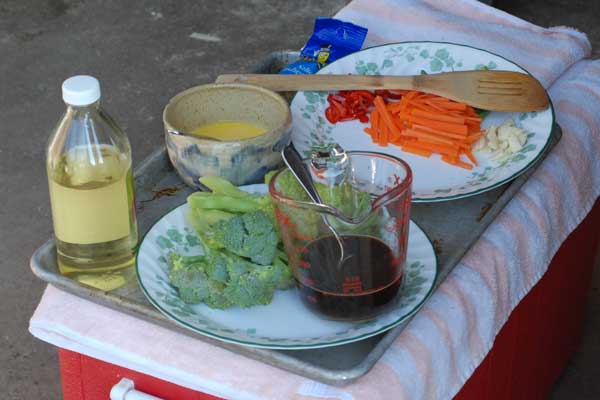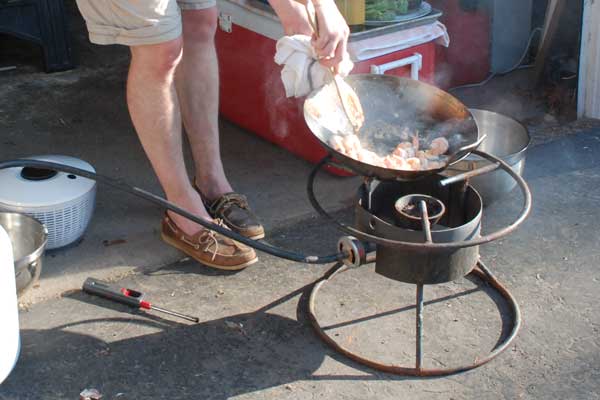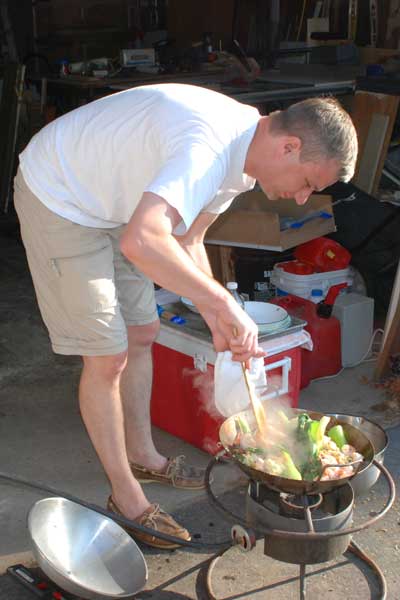What to do when it’s really really hot and sticky, again? Cook outdoors! That’s exactly what we did on Wednesday night, as predicted.
We didn’t have anything that was grill-suitable in the house. But we did have lots of veg, and shrimp in the freezer, and rice noodles in the cabinet. Sounds like stir-fry!
Like most good cooks, we start by preparing ingredients. This is particularly crucial for a stir-fry, and even more so when we cook one outside. This sheet pan contains most of what went into dinner: the broccoli, broken down into florets; cut-up carrots, Dutch chile (this is a long red chile that we first used in the Netherlands, and our local supermarket has them also), and garlic; a couple of garlic scapes, also cut up; a tube of cashews; a couple of beaten eggs; the sauce, which contained soy sauce and fish sauce and I don’t know what else; and the bottle of peanut oil. Other things not in this picture: the pak choy or bok choy or whatever that green was, cut into leaves; two servings of shrimp, thawed and peeled; and a big bowl with rice noodles soaking in water.
Here’s the cooking rig. It’s the propane burner that Casey uses for brewing beer, which means boiling vast quantities of water with other stuff, so it puts out lots of heat. Consequently, it’s also great for stir-frying. The biggest drawback is the height, or lack thereof. For homebrewing, it’s not as big a deal, because the pot Casey uses is gigantic, and a low burner means you don’t have to lift a huge pot full of water so high, and it’s also easier to see over the top of. For stir-frying, it would be a little less back-breaking if it were up off the ground.
The wok we used was a gift from our friend the Chocolate Doctor. We didn’t want to use our cheapo non-stick wok on this burner, because we were afraid of what the heat would do to the non-stick surface. We had a “stick” wok once upon a time, but we never were able to keep its surface seasoned, so we eventually pitched it. That wok, like our cheapo wok, had a long handle, which was nice for tossing the wok. This wok has just the two “ears” for handles, which isn’t so good when you’re working over a very hot burner, but we think we can solve that problem with some nice big vise grips. I hope I’m at a hardware store before our next outdoor stir-fry.
The procedure we used for this stir-fry was similar to our last stir-fry: start by heating the wok, and then get the protein (in this case, the shrimp) underway. I think Casey must have tossed the shrimp with some cornstarch, because the bowl they’d been in had a white powdery coating. When the shrimp were pretty much cooked, they came out and got set aside. Then the veg went into the wok with another splash of peanut oil: first the things that would take longer to cook, like the broccoli, with splashes of water added to help them steam; ending with the quickly-cooking bits like the garlic scapes. When the veg were done, they, too, came out. The eggs got quickly scrambled, and then taken out. Then, the noodles (now completely hydrated) went into the wok, with the sauce.
And everything went into the wok again, with the noodles and sauce, to warm through and combine. And that was it: the dirty dishes got piled onto the sheet pan to get brought upstairs. The hot wok came up with its contents. Upstairs, the completed stir-fry (or pad thai, or whatever you want to call it) got a few last garnishes (fresh carrot, a sprinkle of chile, lime wedges, a splash of fish sauce, a chiffonade of basil).
And dinner was served.
One thing that’s not clear from these photos is that the broccoli and bok choy were left in large chunks. This wasn’t as easy to eat as it could have been. Next time, I think the bok choy in particular would benefit from having the stems cut crosswise into shorter lengths, to keep me from splattering sauce as I ate. But other than that, it was a perfect dinner for a hot night.




Yes, the low height is a problem for cooking, but great for brewing. However I believe, I’ve thought of a solution to this problem for the next time. Now if I can just remember it.
Comment by Casey — July 11, 2010 @ 18:37 PM
Yum. You guys have an abundance of patience. Here’s to you.
Comment by murrayfishel — May 11, 2015 @ 07:08 AM